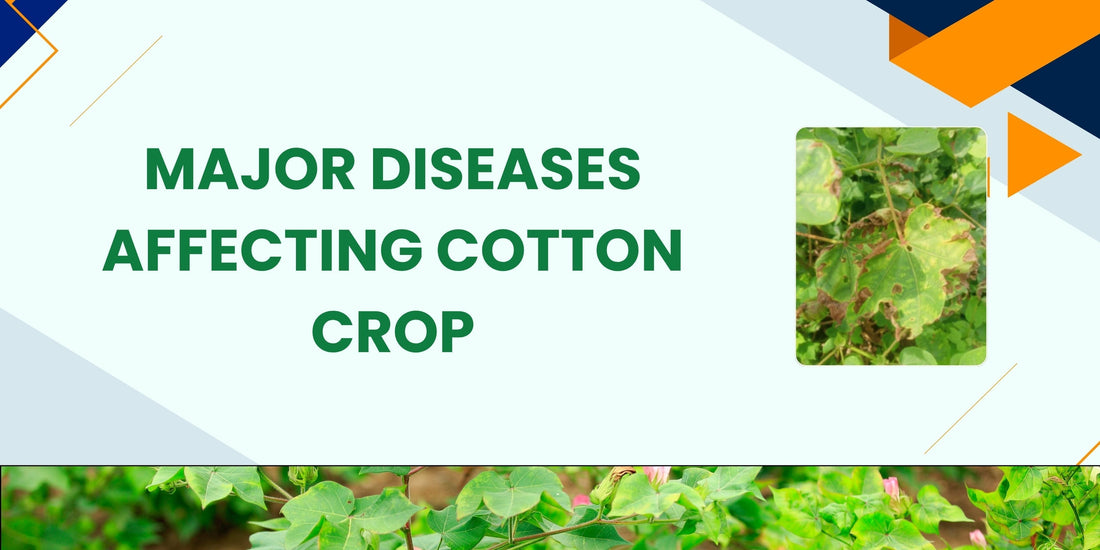
MAJOR DISEASES AFFECTING COTTON CROP
Introduction:
Cotton is one of the most important fiber and cash crop of India and plays a dominant role in the industrial and agricultural economy of the country. It provides the basic raw material (cotton fibre) to cotton textile industry. Cotton in India provides direct livelihood to 6 million farmers and about 40-50 million people are employed in cotton trade and its processing.
In India, there are ten major cotton growing states which are divided into three zones, viz. north zone, central zone and south zone. North zone consists of Punjab, Haryana, and Rajasthan. Central zone includes Madhya Pradesh, Maharashtra and Gujarat. South zone comprises Andhra Pradesh, Telangana, Karnataka and Tamil Nadu. Besides these ten States, cotton cultivation has gained momentum in the Eastern State of Orissa. Cotton is also cultivated in small areas of non-traditional States such as Uttar Pradesh, West Bengal & Tripura.
List of Diseases in Cotton:
- Cercospora leafspot
- Bacterial leaf blight
- Alternaria leafspot
- Tobacco streak virus
- Grey mildew
- Internal boll rot
- Fusarium wilt
- Texas Rootrot
- Anthracnose
- Verticillium wilt.
Major Diseases in Cotton:
1.Cercospora leafspot:
Casual organism: Cercospora gossypina
Symptoms:
- Reddish lesions will occur during the early stages.
- As the disease progresses, the lesions enlarge and turn white to light brown in the center.
- The lesions are circular and vary in size.
- Concentric zones are often present with a red color at the margins.
Survival and mode of spread:
- The pathogen survives in the infected plant debris.
- The conidia are spread by wind or rain splash.
Favourable Conditions:
- Dense planting.
- Cloudy weather coupled with intermittent rain followed by dry weather.
-
High relative humidity.
Management:
- Remove and destroy infected plant debris.
- Maintaining plant vigor through proper soil fertility and irrigation.
- Should not plant cotton after cotton.
2. Tobacco Streak Virus:
It is a pathogen that causes cotton necrosis.The virus is transmitted mainly by thrips.
Symptoms:
- Necrotic streaks are produced on the petiole.
- Initially chlorotic yellow spot appear on the infected leaves.
- Later spot turn into distinct necrotic purple spot with yellow halo.
- Bud and flower productions are reduced.
- Severe infection resulted in drying of squares.
Survival and Mode of Spread
Virus survives in alternate hosts.
Primary spread is From infected plants.
The virus is transmitted by Thrips (Thrips tabaci).
Favourble Conditions:
Minimum temperature, High relative humidity with leaf wetness.
Management:
Remove infected plants and other host plants.
Periodical weeding should be done.
Seed treatment with imidacloprid 70WS at 7g/kg.
3. Bacterial leaf blight:
Casual organism: Xanthomonas campestris p.v malvacearum.
Symptoms:
The bacterium attacks all stages from seed to harvest.
Five common phases of symptoms are:
- Seedling blight:
- Small water-soaked, circular or irregular lesions on the cotyledons.
- Infection spreads to stem through petiole and cause withering and death of seedlings.
2. Angular Leaf Spot:
- Small, dark green, water soaked areas develop on lower surface of leaves.
- The spots become angular restricted by veins and veinlets and are visible on both the surface of leaves.
-
Later they turn reddish brown colour and infection spreads to veins and veinlets.
3. Vein necrosis or Vein banding:
- Blackening of the veins and veinlets, gives a typical 'blighting' appearance.
- On the lower surface of the leaf, bacterial oozes are formed as crusts or scales.
- The leaves become crinkled and twisted inward and show withering.
- The infection also spreads from veins to petiole and cause blighting leading to defoliation.
4. Blackarm:
- On the stem and fruiting branches, dark brown to black lesions are formed.
- Girdle the stem and branches to cause premature droopingoff of the leaves.
- Cracking of stem and gummosis, resulting in breaking of the stem and hang typically as dry black twig to give acharacteristic "black arm" symptom.
5. Square rot or boll rot:
- On the bolls, water soaked lesions appear and turn into dark black and sunken irregular spots.
- Infection slowly spreads to entire boll and shedding occurs.
- Infection on mature bolls lead to premature bursting.
- The bacterium spreads inside the boll and lint gets stained yellow because of bacterial ooze and loses its appearance and market value.
- The pathogen also infects the seed and causes reduction in size and viability of the seeds.
Survival and Mode of Spread:
- The bacterium survives on infected, dried plant debris in soilfor several years.
- The bacterium is also seed-borne and remains in the form of slimy mass on the fuzz of seed coat.
- The primary infection is through seed-borne bacterium.
- Secondary spread is through wind, windblown rain splash,irrigation water, insects and other implements.
Favourable Conditions:
- Optimum soil temperature of 28°C,
- High atmospheric temperature of 30-40°C,
- Relative humidity of 85 per cent Poor tillage, late irrigation
- Potassium deficiency in soil.
- Rain followed by bright sunshine during the months of October and November.
Management:
- Delint the cotton seeds with concentrated sulphuric acid at100ml/kg of seed.
- Treat the delinted seeds with Carboxin or Oxycarboxin at 2 g/kg or Carboxin 37.5% + Thiram 37.5% WS @2.5 g/kg.
- Remove and destroy the infected plant debris.
- Rogue out the volunteer cotton plants and weed hosts.
- Follow crop rotation with non-host crops.
- Early thinning and early earthing up with potash.
4.Fusarium wilt:
Casual organism: Fusarium oxysporum f.sp.vasinfectum
Symptoms:
- Yellowing and browning of cotyledons followed by browning on the petiole.
- Loss of turgidity, yellowing, drooping and wilting of leaves.
- Browning or blackening of vascular tissues.
- Infected plants appear stunted with fewer bolls.
Survival and Mode of Spread:
- Survive in soil as saprophyte for many years and chlamydospores act as resting spores. Primary spread is through seed, dormant hyphae and chlamydospores.
- The pathogen is externally and internally seed-borne.
- Secondary spread by wind and irrigation water.
Favourable Conditions:
- Soil temperature of 20-30 °C.
- Hot and dry periods followed by rains.
- Heavy black soils with an alkaline reaction
- Increased dose of nitrogen and phosphatic fertilizers.
-
Wounds caused by nematode (Meloidogyne incognita) and grubs of Ash weevil (Myllocerus pustulatus).
Management:
- Remove and burn the infected plant debris in the soil after deep summer ploughing.
- Apply farm yard manure or other organic manures @ 4 t/ac.
- Follow mixed cropping with non-host plants to reduce the soil temperature below 2000 by providing shade.
- Treat the acid-delinted seeds with Chlorothalonil at 4 g/kg of seed.
- Spot drenching with carbendazim50%WP@1g/lit of water.
5.Verticillium wilt:
Casual organism: Verticillium dahliae
Symptoms:
- Affects the crop in square and boll formation stages.
- Bronzing of veins followed by interveinal chlorosis, yellowing and scorching of leaves.
- Leaves exhibit drying of leaf margins and areas between veins shows "Tiger stripe symptom"
- Affected plants remain barren showing pinkish discoloration in stem and wood.
Survival and mode of Spread:
- Survive in the infected plant debris and in soils as microsclerotia up to 14 years. Seeds also carry microsclerotia and conidia in the fuzz.
- Primary spread through soil.
- Secondary spread through the contact of diseased roots to healthy ones and through dissemination of infected plant parts through irrigation water and other implements.
Favourable Conditions:
- Low temperature of 15-200C, low lying and ill-drained soils.
- Heavy soils with alkaline condition.
- Heavy doses of nitrogenous fertilizers.
Management:
- Remove and burn the infected plant debris in the soil after deep summer ploughing.
- Apply farm yard manure or other organic manures @4 t/ac.
- Follow mixed cropping with non-host plants to lower the soil temperature below 200C by providing shade.
- Follow crop rotation by growing paddy or lucerne or chrysanthemum for 2-3 years.
FAQ’S:
1. Which diseases are most prevalent in cotton crops ?
Cotton leaf curl virus, bacterial blight, fusarium wilt, verticillium wilt, boll rot, root rot, and leaf spot are some of the most prevalent diseases that impact cotton crops.
2. What are the effects of bacterial blight on cotton plants ?
Xanthomonas citri pv. malvacearum is the causative agent of bacterial blight, which causes water-soaked lesions on leaves, stems, and bolls. It can result in stunted growth, decreased photosynthesis, and early leaf loss, all of which diminish output.
3. How does fusarium wilt spread and what is it ?
The fungus Fusarium oxysporum is the cause of fusarium wilt. Through the roots, it enters the plant and obstructs water flow, causing wilting and eventual plant death. It spreads by way of plant waste and contaminated soil.
4. How may verticillium wilt be avoided or controlled by farmers ?
Cool, damp soil is ideal for Verticillium wilt, which is caused by Verticillium dahliae. Crop rotation, the use of resistant cultivars, soil fumigation, and proper soil drainage are some ways farmers can control it.
5. How can cotton crops be protected against diseases ?
Important preventive measures include crop rotation, planting resistant cultivars, keeping the soil healthy, applying balanced fertilizer, and keeping an eye out for pests like whiteflies. It can also be beneficial to avoid overhead irrigation and make sure there is adequate ventilation surrounding plants.
Conclusion:
Controlling cotton diseases including bacterial blight, fusarium wilt, verticillium wilt, tobacco streak virus, and cercospora leaf spot is essential to preserving crop health and maximizing productivity. These illnesses, which are brought on by a variety of pathogens, impact cotton plants' leaves, stems, and vascular system. In extreme situations, they can cause wilting, decreased photosynthesis, and even plant mortality. Crop rotation, the use of resistant cotton types, good sanitation, and the prompt use of pesticides and fungicides are all examples of effective management techniques. By combining these tactics, integrated pest management (IPM) techniques can offer environmentally responsible and long-lasting disease control. Given that cotton is a significant commodity, more investigation into disease-resistant cultivars and creative management techniques will be necessary to boost cotton profitability and productivity.
